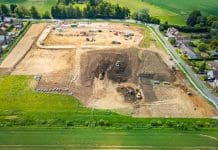Tom Wells, Head of Environmental Planning and Assessment at CBRE UK, summarises the key changes in Environmental Impact Assessment Regulations
While the EIA process remains broadly the same as under previous sets of EIA Regulations, there are some notable changes that developers and determining authorities need to be aware of. These include a couple of minor amendments to the draft Regulations that were consulted on in December 2016 and one unintended change that is the result of a drafting error on the part of DCLG.
Screening determination
The local authority has to state the main reasons for its determination. If they determine that EIA is not required, the screening opinion must state any features of the proposed development and/or measures required to avoid or prevent what might otherwise have been significant environmental effects, without which they would have determined that EIA was required. There may be a need to re-screen proposals where such measures are not included in the final scheme submitted for planning, which might result from design evolution.
Assessment scope
The term ‘human beings’ has been replaced with ‘population and human health’ and ‘flora and fauna’ has been replaced by the term ‘biodiversity, with particular attention to species and habitats protected under Directive 92/43/EEC and Directive 2009/147/EC’ (i.e. the Habitats Directive and Wild Birds Directive). There are also additional requirements to consider the vulnerability of projects to risks of major accidents and/or disasters, as well as explicit references to greenhouse gases and hydromorphological changes. While the new Regulations increase the scope of EIA, it is a process that should still only focus on the likely significant environmental effects of a project, so these topics will only be relevant in certain circumstances.
Determining the scope
The changes refer to the Environmental Statement (ES) being “based on the most recent scoping opinion or direction issued (so far as the proposed development remains materially the same as the proposed development which was subject to that opinion or direction)”. All information requested in a scoping opinion will be required to form part of the ES. It will, therefore, be important for developers to engage with the determining authority before the issue of the scoping opinion to ensure that requests for information are considered reasonable (e.g. the applicant does not need to try and ‘prove a negative’). The new Regulations do, however, suggest that more than one scoping opinion can be issued, so this could potentially be another course of action to address any unreasonable requests for information.
Competent experts/sufficient expertise
This is arguably the most significant of the changes, with the terms ‘competent expert’ and ‘sufficient expertise’ not being defined. There is a requirement that the ES must be prepared by persons who, in the opinion of the developer, have sufficient expertise to ensure the completeness and quality of the ES. This change is likely to be most relevant when it comes to the credentials of EIA examiners, however, who are required to have or have access to, sufficient expertise to examine the ES. There is a risk that objectors could use this new requirement to call into question the competency of the authority to determine an application for ‘EIA development’.
While not explicitly stated in the EIA Directive or EIA Regulations, it is implied that EIA screening should also be undertaken by competent experts. It would be strange that EIA needs to be undertaken/examined by persons who meet the requirements, without a decision on whether or not it needs to be undertaken in the first place being arrived at without their involvement. The change should lead to improvements in the quality of EIA, with it no longer being viewed by some as something that can be ‘bolted on’ to the services of other non-EIA consultants within project teams.
Consultation timeframes
The period for public consultation on the ES or any additional environmental information is to be extended to a minimum of 30 days, up from 21 days.
Cumulative effects
The requirement for considering cumulative schemes has been restricted to ‘cumulation with other existing development and/or approved development’. This omits the previous requirement to assess schemes that are ‘reasonably foreseeable’ (e.g. were allocated for future development). While limited to the consideration of existing or consented developments; there may still be situations where it is sensible to assess the cumulative effects of a project alongside emerging proposals on nearby sites. This will avoid a race to securing consent, at which point the information related to the second application would become out of date.
Up-to-date reasoned conclusion
The changes state that a competent authority’s reasoned conclusion on the significant impacts of a proposal needs to be “up-to-date” at the time a final decision is taken. This has the potential to present problems where there is a long gap between the submission of the ES and a decision being taken or where subsequent applications are being determined in relation to ‘EIA development’.
Industrial estate developments
This is the unintended change mentioned earlier. The screening threshold for industrial estates has been lowered from 5 hectares (set in 2015) back to 0.5 hectares (set originally in 2011). In practice, this means that any proposed industrial estate above 0.5 hectares will fall within the scope of the EIA Regulations and will, therefore, need to be screened to see whether EIA is required.
Other administrations and planning regimes
The changes outlined above are broadly the same for town planning projects in Scotland and Wales, as well as infrastructure projects throughout the UK. Minor differences include the use of the term ‘EIA Report’ in Scotland, and different requirements around competency in Wales, where it is for the local authority or Welsh Ministers to satisfy themselves of the competence of those preparing the ES rather than the developer. The Regulations in Northern Ireland are yet to be updated, though the requirements of the EIA Directive still apply.
Tom Wells
Head of Environmental Planning and Assessment
CBRE UK
Tel: +44 20 7182 2000













